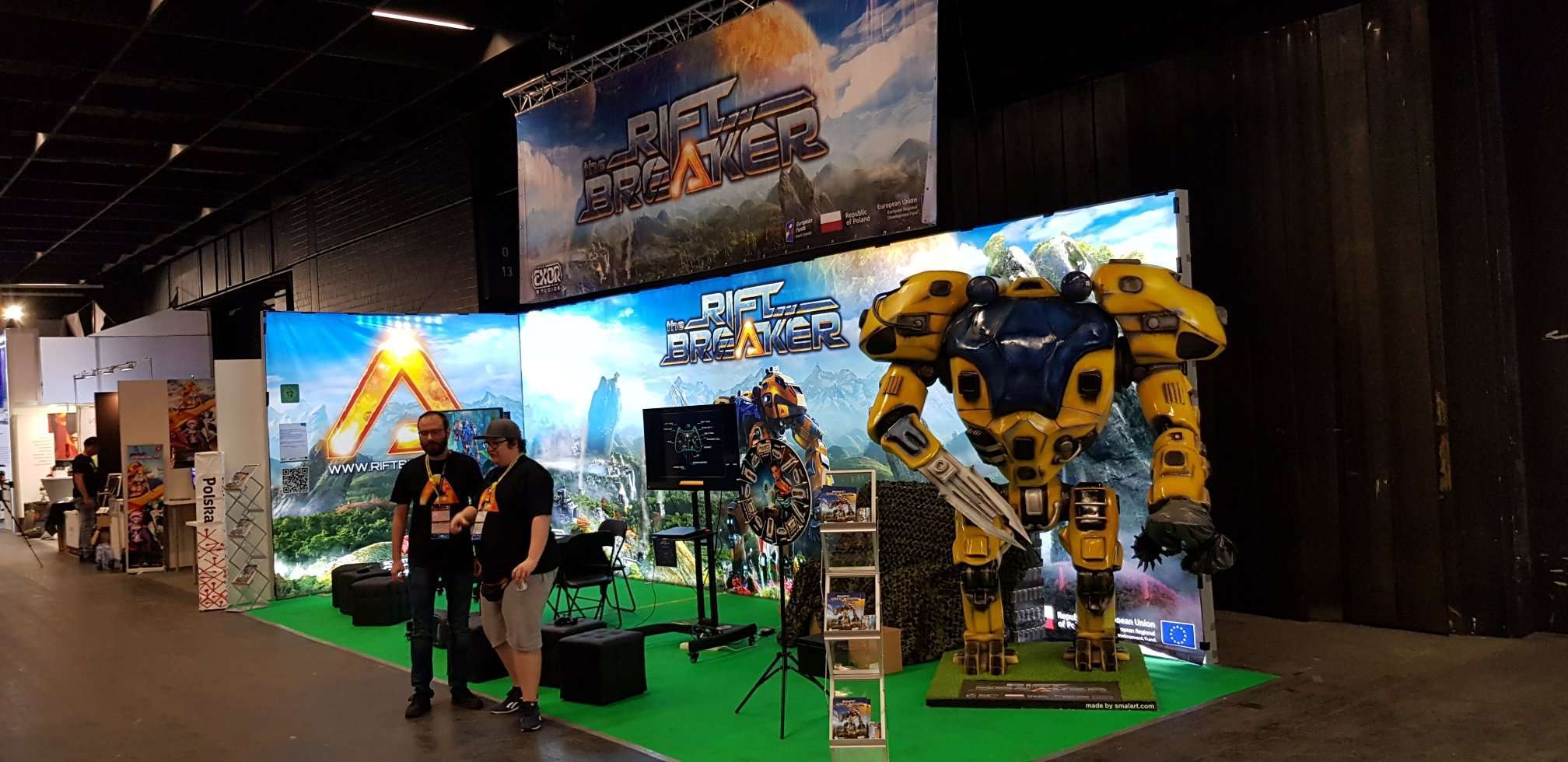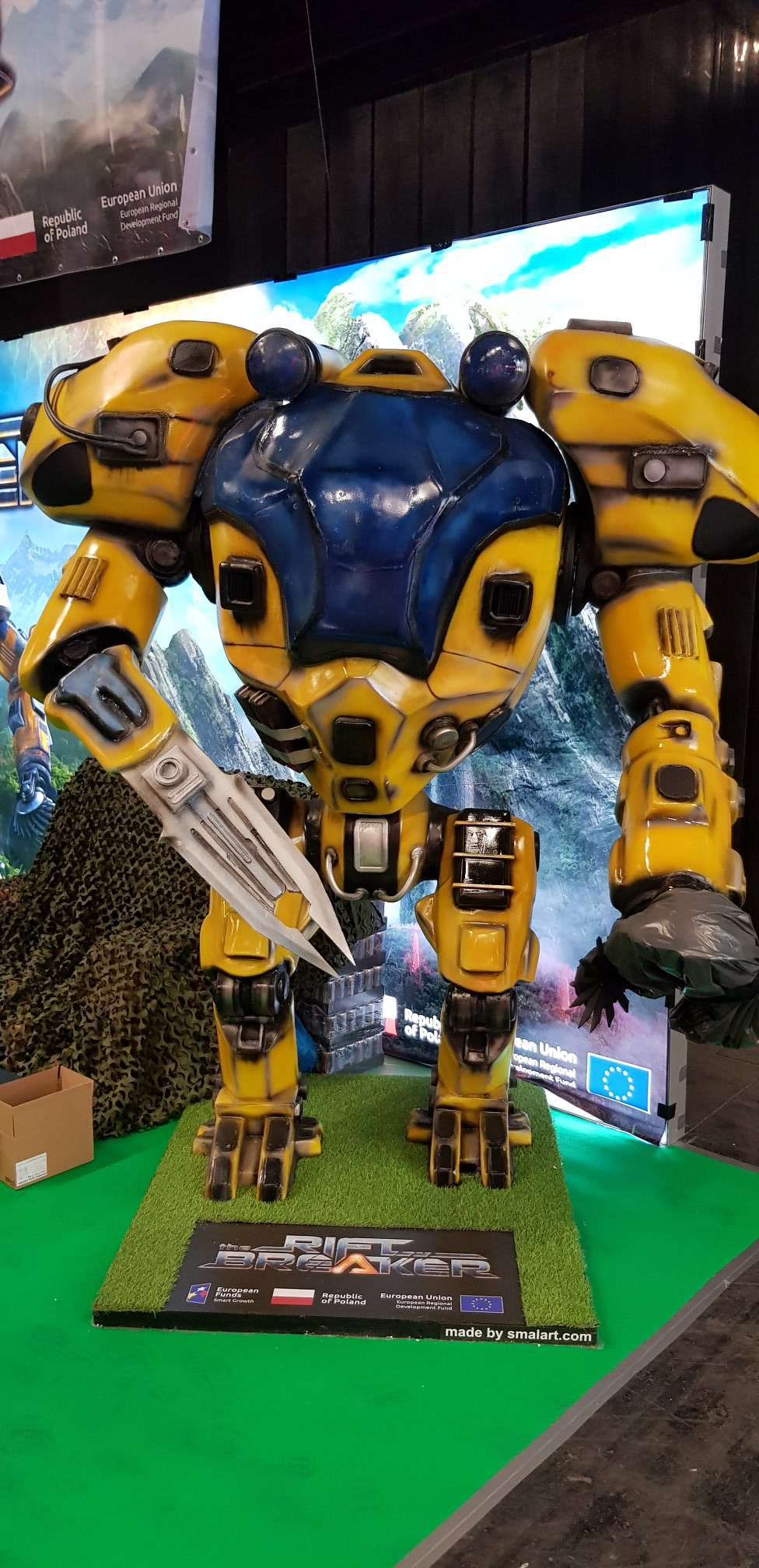 Kaboom.
Kaboom.When a Steam user left a review on the X-Morph: Defense Store Page saying that the game looked as if it was directed by Michael Bay, it dawned on us - there are lots of explosions in our games. We never gave that much thought, to be honest, but taking a look back it has always been true for all our projects. We love blowing things up and we think we’re quite good at it, so we would like to tell you what goes into creating realistic-looking explosions (and other effects) for EXOR Studios games, including The Riftbreaker.
 A sample scene from Zombie Driver HD. There are lots of particles in this one - blood, sparks, explosions… The game wouldn’t be the same without these effects.
A sample scene from Zombie Driver HD. There are lots of particles in this one - blood, sparks, explosions… The game wouldn’t be the same without these effects.The explosions you see in our games are realized through the extensive use of the particle effects system. The particles are prepared by our artist in a specialized tool and then imported into the game. They consist of quadrilaterals (two-dimensional shapes, often referred to as ‘quads’) with a texture and set transparency. The artist can give each of the quads different properties, changing their overall appearance and how they behave in relation to other quads within the same effect, but it is the texture that is the base of it all. In much simpler terms - we set flat images in motion, make them see-through and add some eye candy.
 A view from the editor we use - Particle Universe. The tree goes on and on, and each node is a different variable!
A view from the editor we use - Particle Universe. The tree goes on and on, and each node is a different variable!You need to have a general idea of what you want to achieve and pick the right textures for the job. There are many types you can choose from. They vary between each other in how they interact with other textures in terms of light and transparency. We mainly use emissives (textures that appear as if they were light sources and can be blended with textures that are underneath them) and refracts (special textures that distort the surrounding area, like in the case of hot air, or a shockwave). When we are not working on explosions, we also make use of alpha blend textures. They do not fake being light sources, but simply mix with other textures in their vicinity. The whole process of creating a particle effect begins with choosing the right texture for the context.
 By choosing correct textures you can get a whole range of effects.
By choosing correct textures you can get a whole range of effects.Every effect consists of sub effects. They are lower-level structures that allow you to group quads together and apply some properties to them - more on those properties later, but in general - you can individually move the sub effects and make them behave in a certain way. Of course, it is extremely important to position the sub effects right. You don’t want a large cloud of black smoke to cover up all the fire, sparks and debris from the remaining ones. In general, you need to start creating an effect with a clear end goal in mind. Reference videos and images are very useful at this point.
 The effects look different in editor and in game, so it’s necessary to test everything live. By the way - this explosion consists of 1042 quads!
The effects look different in editor and in game, so it’s necessary to test everything live. By the way - this explosion consists of 1042 quads!Another important piece of the puzzle is the emitter. Every sub effect contains one. It can be seen as the ‘starting point’ of the particle. It controls the spatial properties of the effect. The quads are spawned from the emitter, and the artist specifies all their properties. The particles can be rendered at any given angle, or they can be set to always face the camera. They can be moved in any direction and at any speed, giving the creator complete control over the end result. That’s already a lot of steps, and we’re not done yet.
 Boss dying in X-Morph: Defense - let the images speak for themselves.
Boss dying in X-Morph: Defense - let the images speak for themselves.What you can add on top of the quads rendered by the emitter are the so-called affectors. An affector is a function that can change the quad you’ve already rendered, for example by changing its transparency or color over time. Take a cloud of smoke as an example. The affector will change it in a couple of ways over its lifetime. First, it will be quite small and opaque, growing larger over time and becoming more transparent, just like smoke in real life. Thanks to the affectors we can control when and how quickly it happens and which direction should the quad move.
 The Riftbreaker will feature lots of particles, and since we are always learning new things, you can expect them to be even more flashy!
The Riftbreaker will feature lots of particles, and since we are always learning new things, you can expect them to be even more flashy!Combining all these things together is a difficult, but incredibly exciting task. It takes years of practice and hours of watching real-life examples of the effects you want to simulate to reach proficiency. We’re pretty sure our particle artist is on several watchlists by now, because of all the videos of explosions, fires and controlled demolitions he has googled over time. Still - worth it!
Next time we will tell you about sequences of explosions - something even more spectacular :) Stay tuned and join the Discord! www.discord.gg/exorstudios
Our social media:
www.facebook.com/exorstudios
www.twitter.com/exorstudios
www.mixer.com/exor_studios
www.twitch.tv/exorstudios
www.youtube.com/exorstudios





 You still have a chance to survive in The Riftbreaker when your HQ explodes, but you will have a lot of cleaning up to do.
You still have a chance to survive in The Riftbreaker when your HQ explodes, but you will have a lot of cleaning up to do. Multiple buildings changing their state at once is often a sight to behold.
Multiple buildings changing their state at once is often a sight to behold. Friendly fire is not a thing in The Riftbreaker, but we used it to show you different destruction levels for the Armory in a controlled environment.
Friendly fire is not a thing in The Riftbreaker, but we used it to show you different destruction levels for the Armory in a controlled environment. The core blowing up in X-Morph: Defense is not a positive thing, but the visuals at least make up for the game loss.
The core blowing up in X-Morph: Defense is not a positive thing, but the visuals at least make up for the game loss. A particle effect can be attached to any of the yellow spheres.
A particle effect can be attached to any of the yellow spheres. We started playing around with explosion sequences in X-Morph: Defense.
We started playing around with explosion sequences in X-Morph: Defense. Kaboom.
Kaboom. A sample scene from Zombie Driver HD. There are lots of particles in this one - blood, sparks, explosions… The game wouldn’t be the same without these effects.
A sample scene from Zombie Driver HD. There are lots of particles in this one - blood, sparks, explosions… The game wouldn’t be the same without these effects. A view from the editor we use - Particle Universe. The tree goes on and on, and each node is a different variable!
A view from the editor we use - Particle Universe. The tree goes on and on, and each node is a different variable! By choosing correct textures you can get a whole range of effects.
By choosing correct textures you can get a whole range of effects. The effects look different in editor and in game, so it’s necessary to test everything live. By the way - this explosion consists of 1042 quads!
The effects look different in editor and in game, so it’s necessary to test everything live. By the way - this explosion consists of 1042 quads! Boss dying in X-Morph: Defense - let the images speak for themselves.
Boss dying in X-Morph: Defense - let the images speak for themselves. The Riftbreaker will feature lots of particles, and since we are always learning new things, you can expect them to be even more flashy!
The Riftbreaker will feature lots of particles, and since we are always learning new things, you can expect them to be even more flashy!


